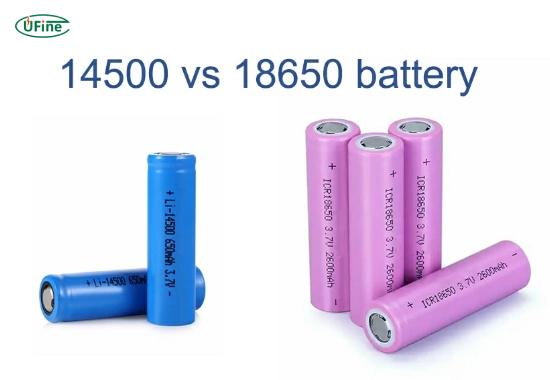
- Part 1. What is a 14500 battery?
- Part 2. What is an 18650 battery?
- Part 3. Size comparison: 14500 vs. 18650 battery
- Part 4. Capacity comparison: 14500 vs 18650 battery
- Part 5. Voltage specifications: 14500 vs 18650 battery
- Part 6. Performance metrics: 14500 vs 18650 battery
- Part 7. Applications of the 14500 battery
- Part 8. Applications of the 18650 battery
- Part 9. Choosing between 14500 and 18650 batteries
- Part 10. FAQs
In today’s technology-driven world, batteries are essential for powering many devices, from smartphones to electric vehicles. Among the various types of batteries available, the 18650 and 14500 lithium-ion batteries stand out as two of the most popular choices. Understanding the differences between these two battery types can help consumers make informed decisions based on their specific needs. This article provides a comprehensive comparative analysis of the 14500 battery and 18650 battery, exploring their characteristics, applications, and performance metrics.
Part 1. What is a 14500 battery?
The 14500 battery is a rechargeable lithium-ion battery with a cylindrical shape. Its name comes from its dimensions: it has a diameter of 14 mm and a length of 50 mm, similar to a standard AA battery.
Key Characteristics of 14500 Batteries
- Capacity: The capacity of 14500 batteries typically ranges from 600 mAh to 1200 mAh. This means they can store enough energy to power small devices for a reasonable amount of time.
- Voltage: It operates at a nominal voltage of approximately 3.7 volts, which is standard for many lithium-ion batteries.
- Applications: They are commonly used in portable electronic devices such as flashlights, digital cameras, and remote-controlled toys. Their compact size allows them to fit into devices where space is limited.
- Rechargeability: One significant advantage of the 14500 battery is its ability to be recharged multiple times. This makes it an eco-friendly option compared to single-use batteries.
Overall, the 14500 battery’s compact size and versatility make it an excellent choice for devices where space is at a premium.
Part 2. What is an 18650 battery?
The 18650 battery, on the other hand, is more significant than its 14500 counterpart, with dimensions of 18 mm in diameter and 65 mm in length.
Key Characteristics of 18650 Batteries
- Capacity: The capacity for 18650 batteries ranges significantly higher, typically between 1200 mAh and 3500 mAh. This higher capacity allows these batteries to power larger devices or run longer between charges.
- Voltage: It also operates at a nominal voltage of about 3.7 volts, similar to the 14500, making it compatible with many devices designed for lithium-ion technology.
- Applications: These batteries are commonly used in high-performance devices such as laptops, electric vehicles, power tools, and vaping devices. Their ability to deliver high energy makes them suitable for applications requiring sustained power over extended periods.
- Safety Features: Many modern 18650 batteries have built-in safety features, such as overcharge protection and short-circuit protection, which enhance their reliability for high-drain applications.
The 18650 battery’s larger size and higher capacity make it suitable for applications requiring more power over extended periods.
Part 3. Size comparison: 14500 vs. 18650 battery
One of the most significant differences between the two batteries is their size.
| Feature | 14500 Battery | 18650 Battery |
|---|---|---|
| Diameter | 14 mm | 18 mm |
| Length | 50 mm | 65 mm |
The size difference affects compatibility with devices and the overall energy storage capacity each battery can provide. The larger diameter and length of the 18650 battery allow it to store more energy, making it ideal for power-hungry devices.
Part 4. Capacity comparison: 14500 vs 18650 battery
When it comes to capacity, the distinction is clear:
The 18650 battery can hold significantly more charge (up to 3500 mAh) than the 14500, which maxes out around 1200 mAh.
This means that devices powered by an 18650 battery can run longer between charges than those using a 14500 battery, making them more suitable for high-drain applications like laptops or electric vehicles.
Additionally, the higher capacity allows for better performance in demanding situations where consistent power output is necessary. For example, if you use a high-powered flashlight or an electric bike, you would want an 18650 battery to ensure long-lasting performance without frequent recharging.
Part 5. Voltage specifications: 14500 vs 18650 battery
Both batteries share similar voltage characteristics:
Both operate at a nominal voltage of approximately 3.7 volts.
However, slight variations can occur depending on specific models and manufacturers, so checking compatibility with your device’s requirements is essential.
This voltage consistency means users can use both batteries interchangeably in many applications, but they must consider capacity differences when choosing.
Part 6. Performance metrics: 14500 vs 18650 battery
Discharge Rates
The discharge rates also vary between these two types:
- The 18650 battery typically supports higher discharge rates (up to 10C) than the 14500, which usually supports rates around 0.5C to 1C.
- This makes the 18650 battery ideal for high-performance applications that require bursts of power. For instance, in power tools or electric vehicles where sudden energy spikes are needed, the 18650’s higher discharge capability ensures optimal performance without overheating or damaging the device.
Lifespan
Both batteries have comparable lifespans when properly maintained; however, due to their larger capacity, 18650 batteries may offer more cycles before their performance diminishes significantly. Depending on usage patterns and care, both types can typically last anywhere from 300 to over 1000 charge cycles.
Part 7. Applications of the 14500 battery
Given its compact size and moderate capacity, the 14500 battery is ideal for:
- Flashlights
- Digital thermometers
- Remote controls
- Small electronic gadgets
- Toys
These applications benefit from the smaller form factor without needing extensive power. For example, many compact flashlights use this size because they fit easily into pockets while providing adequate brightness for personal use.
Part 8. Applications of the 18650 battery
In contrast, the higher capacity and discharge rate of the 18650 battery makes it suitable for the following:
- Laptops
- Electric bicycles
- Drones
- High-powered flashlights
- Power tools
These devices require sustained power over more extended periods or during high-demand situations. For instance, electric bikes rely on these batteries for propulsion and powering lights and displays without running out quickly during rides.
Part 9. Choosing between 14500 and 18650 batteries
When deciding between these two batteries, consider:
- Device compatibility: Ensure your device can accommodate either size.
- Power requirements: Assess whether your device needs longer runtimes or higher power output.
- Application type: Choose based on whether you need compactness (for smaller devices) or capacity (for high-drain devices).
Understanding these factors will help you select the right battery type for your needs while maximizing your devices’ performance and efficiency.
Part 10. FAQs
-
What are the main differences between the 14500 and 18650 batteries?
The primary differences include size (14mm x 50mm for the 14500 vs. 18mm x 65mm for the 18650), capacity (600mAh to 1200mAh for the former vs. up to 3500mAh for the latter), and typical applications where each is best suited. -
Which battery lasts longer: 14500 or 18650?
The 18650 battery generally lasts longer due to its higher capacity than the smaller 14500 battery, making it better suited for high-demand applications. -
Can I use a 14500 battery in place of an AA battery?
Yes, since a 14500 battery has similar dimensions to an AA battery, it can often be used as a rechargeable alternative in devices designed for AA batteries. -
Are both the 14500 and 18650 batteries rechargeable?
Yes, the 14500 and 18650 batteries are rechargeable lithium-ion batteries designed for multiple use cycles before they need replacement. -
Can a 14500 battery be used in devices designed for 18650 batteries?
No, you cannot use a 14500 battery instead of an 18650 battery, as they have different sizes and capacities that affect performance in high-drain applications. -
How do I know which battery my device requires: 14500 or 18650?
Before making a purchase decision, check your device’s specifications or user manual to determine whether it requires a specific size or type of lithium-ion battery.
Related Tags:
More Articles

A Complete Guide to the Best Batteries for Flashlights
Discover the best batteries for flashlights: alkaline, lithium, NiMH & rechargeable options. Tips for performance and maintenance.
Graphene Battery vs Lithium Battery: Which is Better?
Compare graphene battery vs lithium battery in energy density, charging speed, lifespan, cost, and EV applications. Learn which battery leads in 2025.
What is the Difference Between MCA and CCA on Batteries?
Learn the difference between MCA and CCA batteries. Understand what MCA means, what CCA is, and how to choose the right battery for vehicles or marine engines.
Type of Lithium Battery Voltage
Learn lithium ion battery voltage, nominal voltage, and voltage range. Compare Li-ion, LiPo, LiFePO4, and 18650 voltages, charging, and device compatibility.
Gel Battery vs Lead Acid: A Detailed Comparison
Compare gel and lead-acid batteries: lifespan, cost, charging, DoD, safety, and key use cases. Find the right battery for solar, marine, EV, UPS, and daily use.





